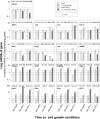Host cell responses to Chlamydia pneumoniae in gamma interferon-induced persistence overlap those of productive infection and are linked to genes involved in apoptosis, cell cycle, and metabolism
- PMID: 17353287
- PMCID: PMC1932845
- DOI: 10.1128/IAI.01045-06
Host cell responses to Chlamydia pneumoniae in gamma interferon-induced persistence overlap those of productive infection and are linked to genes involved in apoptosis, cell cycle, and metabolism
Abstract
The respiratory pathogen Chlamydia (Chlamydophila) pneumoniae is associated with chronic diseases, including atherosclerosis and giant-cell arteritis, which are accompanied by the occurrence of these obligate intracellular bacteria in blood vessels. There, C. pneumoniae seems to be present in a persistent state. Persistence is characterized by modified bacterial metabolism and morphology, as well as a reversible arrest of chlamydial development. In cell culture, this persistent state can be induced by gamma interferon (IFN-gamma). To elucidate this long-term interaction between chlamydiae and their host cells, microarray screening on epithelial HeLa cells was performed. Transcription of persistently (and productively) infected cells was compared with that of mock-infected cells. Sixty-six host cell genes were regulated at 24 h and/or 96 h of IFN-gamma-induced persistence. Subsequently, a set of 17 human host cell genes related to apoptosis, cell cycle, or metabolism was identified as permanently up- or down-regulated by real-time PCR. Some of these chlamydia-dependent host cell responses were diminished or even absent in the presence of rifampin. However, other expression patterns were not altered by the inhibition of bacterial RNA polymerase, suggesting two different modes of host cell activation. Thus, in the IFN-gamma model, the persisting bacteria cause long-lasting changes in the expression of genes coding for functionally important proteins. They might be potential drug targets for the treatment of persistent C. pneumoniae infections.
Figures





Similar articles
-
Up-regulation of host cell genes during interferon-gamma-induced persistent Chlamydia pneumoniae infection in HL cells.J Infect Dis. 2007 Jan 15;195(2):212-9. doi: 10.1086/510314. Epub 2006 Dec 13. J Infect Dis. 2007. PMID: 17191166
-
Silencing or permanent activation: host-cell responses in models of persistent Chlamydia pneumoniae infection.Cell Microbiol. 2005 Aug;7(8):1099-108. doi: 10.1111/j.1462-5822.2005.00534.x. Cell Microbiol. 2005. PMID: 16008577
-
The transcript profile of persistent Chlamydophila (Chlamydia) pneumoniae in vitro depends on the means by which persistence is induced.FEMS Microbiol Lett. 2009 Feb;291(1):120-6. doi: 10.1111/j.1574-6968.2008.01446.x. Epub 2008 Dec 9. FEMS Microbiol Lett. 2009. PMID: 19077059
-
[Effector proteins of Clamidia].Mol Biol (Mosk). 2009 Nov-Dec;43(6):963-83. Mol Biol (Mosk). 2009. PMID: 20088373 Review. Russian.
-
The intracellular life of chlamydiae.Semin Pediatr Infect Dis. 2002 Oct;13(4):239-48. doi: 10.1053/spid.2002.127201. Semin Pediatr Infect Dis. 2002. PMID: 12491229 Review.
Cited by
-
Human enteroendocrine cell responses to infection with Chlamydia trachomatis: a microarray study.Gut Pathog. 2014 Jun 16;6:24. doi: 10.1186/1757-4749-6-24. eCollection 2014. Gut Pathog. 2014. PMID: 24959205 Free PMC article.
-
Novel Insight Into Nutritional Regulation in Enhancement of Immune Status and Mediation of Inflammation Dynamics Integrated Study In Vivo and In Vitro of Teleost Grass Carp (Ctenopharyngodon idella): Administration of Threonine.Front Immunol. 2022 Mar 14;13:770969. doi: 10.3389/fimmu.2022.770969. eCollection 2022. Front Immunol. 2022. PMID: 35359991 Free PMC article.
-
Association of Chlamydia pneumoniae infection with HLA-B*35 in patients with coronary artery disease.Clin Vaccine Immunol. 2008 Jan;15(1):55-9. doi: 10.1128/CVI.00163-07. Epub 2007 Nov 7. Clin Vaccine Immunol. 2008. PMID: 17989341 Free PMC article.
-
Host Cell Amplification of Nutritional Stress Contributes To Persistence in Chlamydia trachomatis.mBio. 2022 Dec 20;13(6):e0271922. doi: 10.1128/mbio.02719-22. Epub 2022 Nov 15. mBio. 2022. PMID: 36377897 Free PMC article.
-
In silico prediction of secretory proteins of Opisthorchis viverrini, Clonorchis sinensis and Fasciola hepatica that target the host cell nucleus.Heliyon. 2021 Jun 5;7(7):e07204. doi: 10.1016/j.heliyon.2021.e07204. eCollection 2021 Jul. Heliyon. 2021. PMID: 34337171 Free PMC article.
References
-
- Baetz, D., K. M. Regula, K. Ens, J. Shaw, S. Kothari, N. Yurkova, and L. A. Kirshenbaum. 2005. Nuclear factor-κB-mediated cell survival involves transcriptional silencing of the mitochondrial death gene BNIP3 in ventricular myocytes. Circulation 112:3777-3785. - PubMed
-
- Blythe, M. J., B. P. Katz, B. E. Batteiger, J. A. Ganser, and R. B. Jones. 1992. Recurrent genitourinary chlamydial infections in sexually active female adolescents. J. Pediatr. 121:487-493. - PubMed
-
- Brantjes, H., N. Barker, J. van Es, and H. Clevers. 2002. TCF: Lady Justice casting the final verdict on the outcome of Wnt signalling. Biol. Chem. 383:255-261. - PubMed
Publication types
MeSH terms
Substances
LinkOut - more resources
Full Text Sources
Medical

